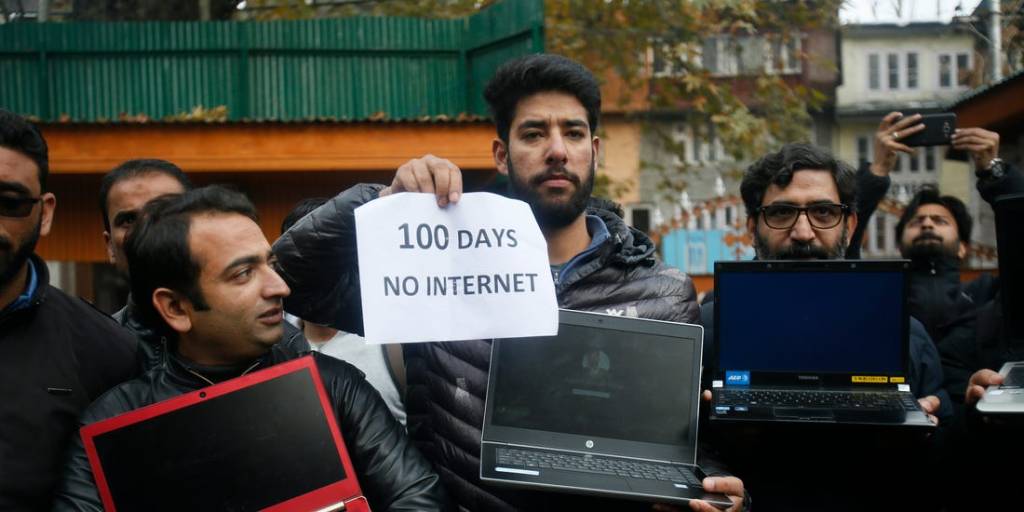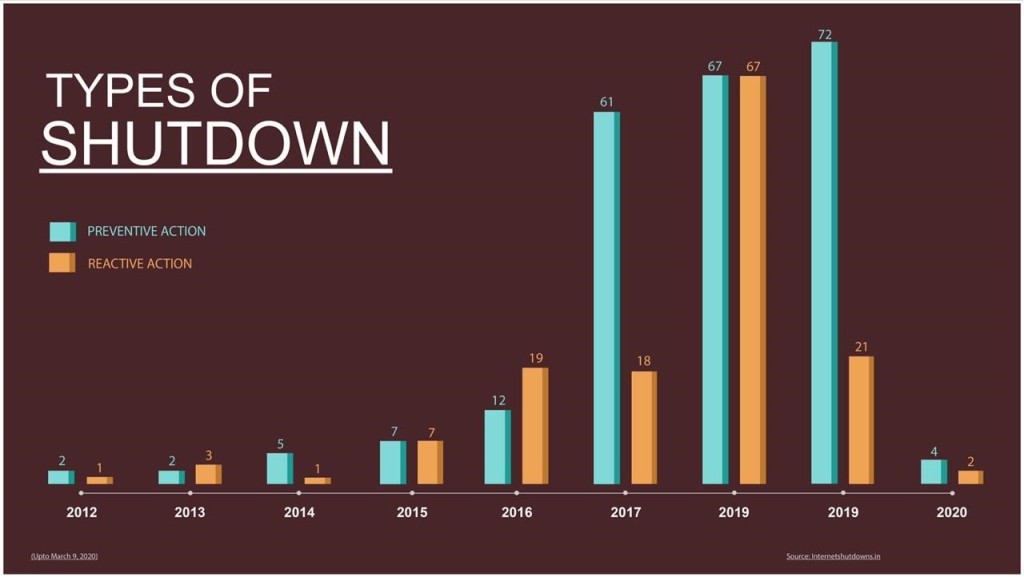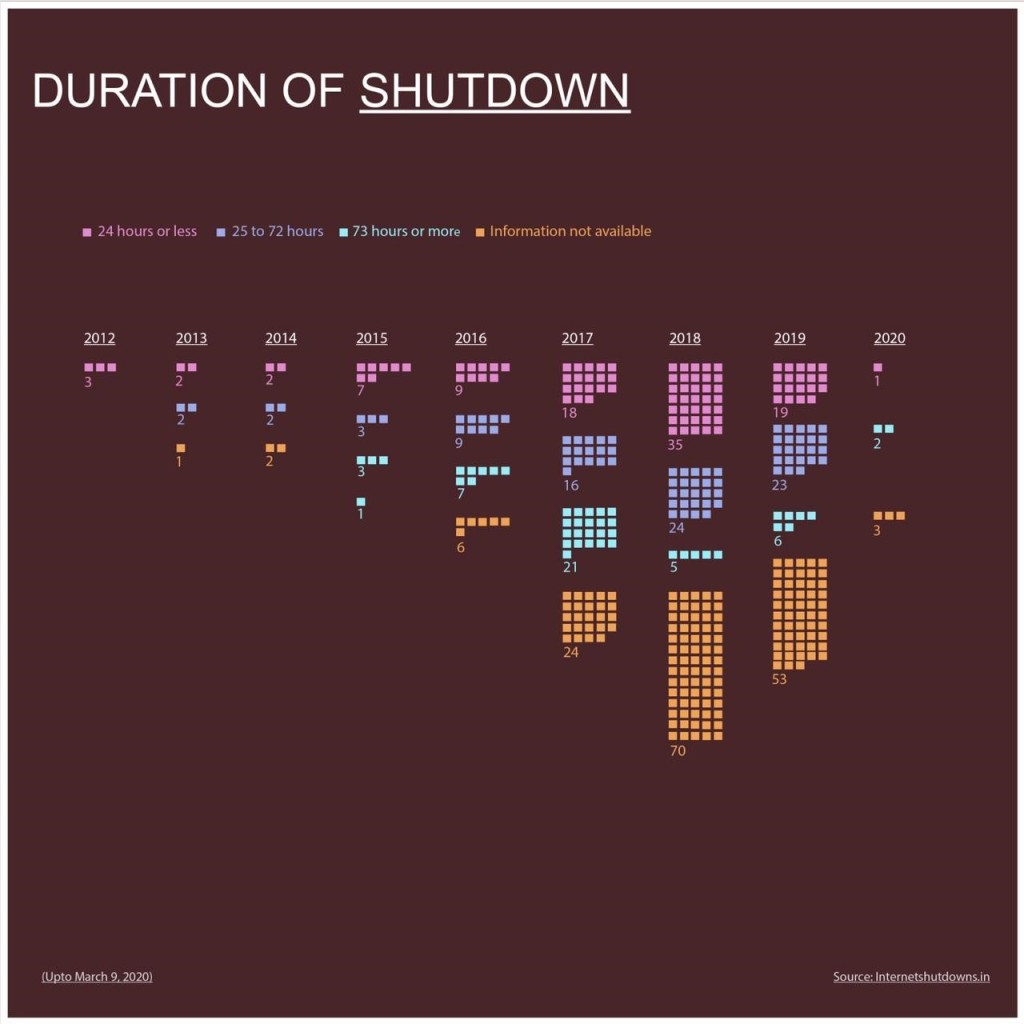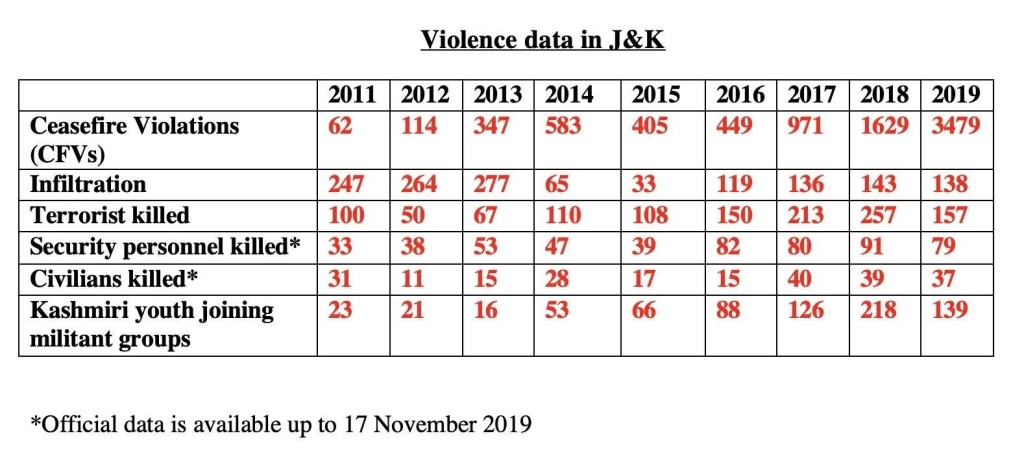This piece originally appeared in Columbia Public Policy Review.

On the night of August 4, 2019, my mother called my sisters and I at around 11:45 P.M.. She said there were rumors something drastic was going to happen in Kashmir. Almost everyone in Kashmir knew there were prospects of something terrible happening, however nobody knew what exactly it was. My family lives in Kashmir and at that time, we siblings were studying and working outside Jammu and Kashmir state. My mother wanted to advise us to be together, in case anything bad happened to them. Over a couple of days, a few governmental implementations and an immediate, unending nightly curfew were imposed which led to ‘fear psychosis’ among the people of Kashmir.
This drastic unknown which people feared but did not know what it would be was the abolition of Kashmir’s special status and an accompanying curtailment of their fundamental rights, followed by a humanitarian crisis that is still in place more than a year after.
WHAT WAS THE PANIC ABOUT?
Kashmir had already been classified as the heaviest militarized zone in the world, but even this designation did not stop the deployment of additional troops. 0.175 million (1.75 lakh) troops were added a few weeks before August 5, 2019. With an occupied area of 63,366 square miles and a population of 6.9 million, Kashmir now had more than 1 million (9.5 lakh) troops. There is now one army personnel for every six[1] Kashmiris or one personnel for every family. Moreover, in an unprecedented move, 300,000 Hindu pilgrims and thousands of tourists were instructed by the government to “curtail their stay” in Kashmir, citing security threats and intelligence reports as reasons. This left the pilgrims, tourists, and the local population anxious and panicked. Furthermore, section 144 of Indian Criminal Procedure Code—a type of curfew barring any group of five or more from congregating in public–was announced to come into effect from 12:00 A.M. of August 5, 2019, 15 minutes after my mother had called me. The announcement also stated “all educational institutions shall also remain closed”, with no further information about when the curfew would be lifted.
Kashmir has been a disturbed zone for decades now. Protests, hartals, short shutdowns on communication and movement have been happening for decades. However, the preparations this time were so frightful that even foreign governments such as Germany and the United Kingdom issued advisories on August 3 to their citizens to leave Jammu and Kashmir (J&K) and avoid all travel to the region. Residents rushed to stock essentials, lined up at gas stations, and called their loved ones in case the internet or phone lines would be shut down. Just as my mother had called us siblings.
THE SHUTDOWN
Indeed, something dire did happen on the morning of August 5, 2019, prompted by two government announcements. First, the federal government demoted the status of J&K from state to union territory, something it had not done with any other state in the history of India. The state-to-union territory change reconstituted the administrative powers of the region from state to the federal administration. Experts call the decision a violation of the constitution of India, which curtailed the legislative and executive powers of elected leaders of J&K. Second, articles 370 and 35A of the Indian Constitution were revoked. This move nullified protection of autonomy of the state which previously allowed it to make its own laws. It also voided the laws which prevented non-residents from buying property in J&K.
These two changes would have resulted in criticism and protests in the state. Two former Chief Ministers of the state had also warned about dire consequences of scrapping Kashmir’s special status. Various experts say the government apprehended “threat of retaliatory terror attacks and associated casualties” as a fallout. Pre-empting fierce resistance against what the experts call an unconstitutional change, the government immediately blocked all travel and communication channels overnight, deeming them as “necessary measures”.
The communication blackout that started then, and continues to be in motion partially even now, is the longest in any democratic country. The shutdown not only blocked phone and internet access, but also landlines, local travel within Kashmir, and travel to and from Kashmir. More than 300 local key activists, academics, and politicians–including all three living former chief ministers and the president of Kashmir Bar Association—were detained. At least 4000 people were arrested and numerous detainees were flown out of Kashmir in military aircrafts because of saturation in jails. The repercussions were also felt in schools, colleges, and hospitals, affecting access to basic education and healthcare services.
The way the lockdown turned out suggests maybe the government did not know how long it would go on, and that is the reason it could not tell people or prepare the state’s administration for it. Or the government knew and it made strategic sense not to tell people for how long it will go on. Citizens would not have been able to mobilize protestors through word of mouth, phone, message, landline, or internet.
HELPLESSNESS OF KASHMIRIS
For a decade now, people in Kashmir are used to sudden, short weekly and monthly internet and phone communication shutdowns. Earlier, the shutdowns used to be in a particular district or two within Kashmir region, but this time, it was in the whole state. Usually, there is no announcement when these modes of communication would be restored, people have to keep checking their phones and keep trying to call friends and family to know about the ban lift. Knowing that, I tried calling my parents, for 10 days continuously, in the hope that phone lines would have been restored. People like me, who were living outside the state, especially students studying outside and in need of fees and rent used to call 40-50 times per day. This protracted chaos and agony traumatized people.


In the desire to reach out to family members, people living inside Kashmir started calling their family and friends from police stations. Because of the communication lockdown, satellite phones and closed group mobile phones were given to select security officials to coordinate among themselves. However, people risked their lives travelling through curfew, waiting for hours outside police stations to make urgent phone calls. This continued for three months. Even this privilege of being able to go to these police stations during curfews could have been availed by, approximately, 9.42%[2] of the Kashmiri population who owned a private vehicle or lived nearby these police stations.
LONGEST EVER INTERNET SHUTDOWN
More than one year since, the people are still suffering due to communication and information access shortage. The internet in Kashmir is allowed to operate only on 2G bandwidth on verified SIM cards. In a commendable decision, in sync with Article 19 of the Universal Declaration of Human Rights declaring internet a human right, the Supreme Court of India, on January 10, 2020, ruled internet access as a fundamental right. However, the same Supreme Court rejected petitions demanding restoration of 4G internet services in Kashmir, on May 11 2020, exactly four months after its first landmark decision. The Court, on August 17, 2020, ordered restoration of 4G internet; however,on “trial-basis” and in a “calibrated manner” in two districts for two months. Attorney general KK Venugopal has said the restrictions have been lifted on an experimental basis and the situation will be reviewed weekly.
The hardships Kashmiri people have faced due to this year-long unending internet shutdown have outweighed peace, stability and development benefits, which the government had aimed to achieve with the state’s status change. The price the people have paid excludes the economic damage of $5.3bn (£4bn) due to just the internet shutdown. Other major damages are not even quantifiable.
Low bandwidth internet has made it impossible to cope with life in Kashmir. People are unable to access information, doctors are unable to keep pace with the latest research and diagnostics, medicines and medical services are hard to access, online education via zoom is affected due to connectivity and stability issues. Young kids have started developing mental health issues, Kashmiris suffering from PTSD are unable to access online counseling platforms, and patients suffering from severe diseases are not able to order medicines online. People are unable to make payments and transactions, small businesses and media houses have shut operations, and the tourism and hospitality industry has been hit along with others.
HAVE PEOPLE’S HARDSHIPS BEEN WORTH IT?
There has also been an offsetting change in the region’s stability. The border infiltration in 2019 (138) has been similar to that of 2017 (136) and 2018 (143), the number of terrorists killed has decreased by 38.9% from 2018 to 2019, the number of security personnel killed is almost the same from 2017 (80) to 2019 (79), and the number of civilians killed has been the same from 2017 (40) to 2019 (37). Kashmiri youth joining militancy, although reduced from 2018 (218) to 2019 (139) due to lack of disruptions in recruitment because of communication shutdown, has still increased by 10.3% as compared to 2017 (126 to 139).

The shutdown has affected the future generations as well. Extrapolating estimated losses for the valley’s school-going children from a World Bank simulation, students have endured more than 1.44[3] years of school learning loss in the last 12 months of school shutdown. This number is an underestimation of the loss; given the children in the state suffer due to conflict, mental health issues, frequent and months-long school shutdowns, internet lockouts, and more. For instance, for almost a decade—from January 2012 to March 2020—the state has suffered 371, hours-long, weeks-long, and months-long internet shutdowns. If we estimate the total learning losses for the generation who are currently in school, the loss would be considerably worse.
RE-INDUCE ROUTINE
Being a conflict zone, plenty of things need to be set right in Kashmir, but perhaps the urgently needed measure is to prevent further humanitarian losses which are likely to have long-term effects. Restoration of full speed internet in all districts of Jammu and Kashmir should be prioritized. It might induce a certain level of routine-normalcy in the scathed lives of people in the state. It will also allow relief in accessing other impaired basic services such as education and health care among others. For example, students taking classes via Zoom will be able to take their classes smoothly without any internet instability issues, doctors will be able to access new research findings and information, especially related to COVID-19 and so on.
[1] Occupied Area= 63,366 square miles. Population= 6.9 million. Troops present= 1 million (9.5 lakhs). Additional troops deployed= 45,000. Total troops now= 9.5 lakhs+ 1.75 lakhs= 11.25 lakhs= 1.125 million. 1 million= 10 lakhs. Troop personnel for how many Kashmiris: 6.9 million Kashmiris / 1.125 million troops= one personnel for every 6.13 Kashmiris. Personnel per sq mile: 11,25,000 personnel/ 63,366 sq miles= 18 personnel per square mile. Average family size in Kashmir according to census of India 2011= 5.8
[2] Kashmir has a population of 69 lakhs. Private vehicles in Kashmir are equal to 6.5 lakhs as per 2018 data from Regional Transport Office (RTO) Kashmir. 69 lakhs divided by 6.5 lakhs gives the percentage of private vehicles owners in Kashmir. https://thekashmirpress.com/2018/09/06/every-year-around-1000-people-die-in-road-accidents-in-jammu-and-kashmir/
[3] According to the study, a school shutdown of 5 months could lead to 0.6 years of schooling adjust for quality, therefore, a 12-month school shutdown could lead to 1.44 years of schooling adjust for quality.